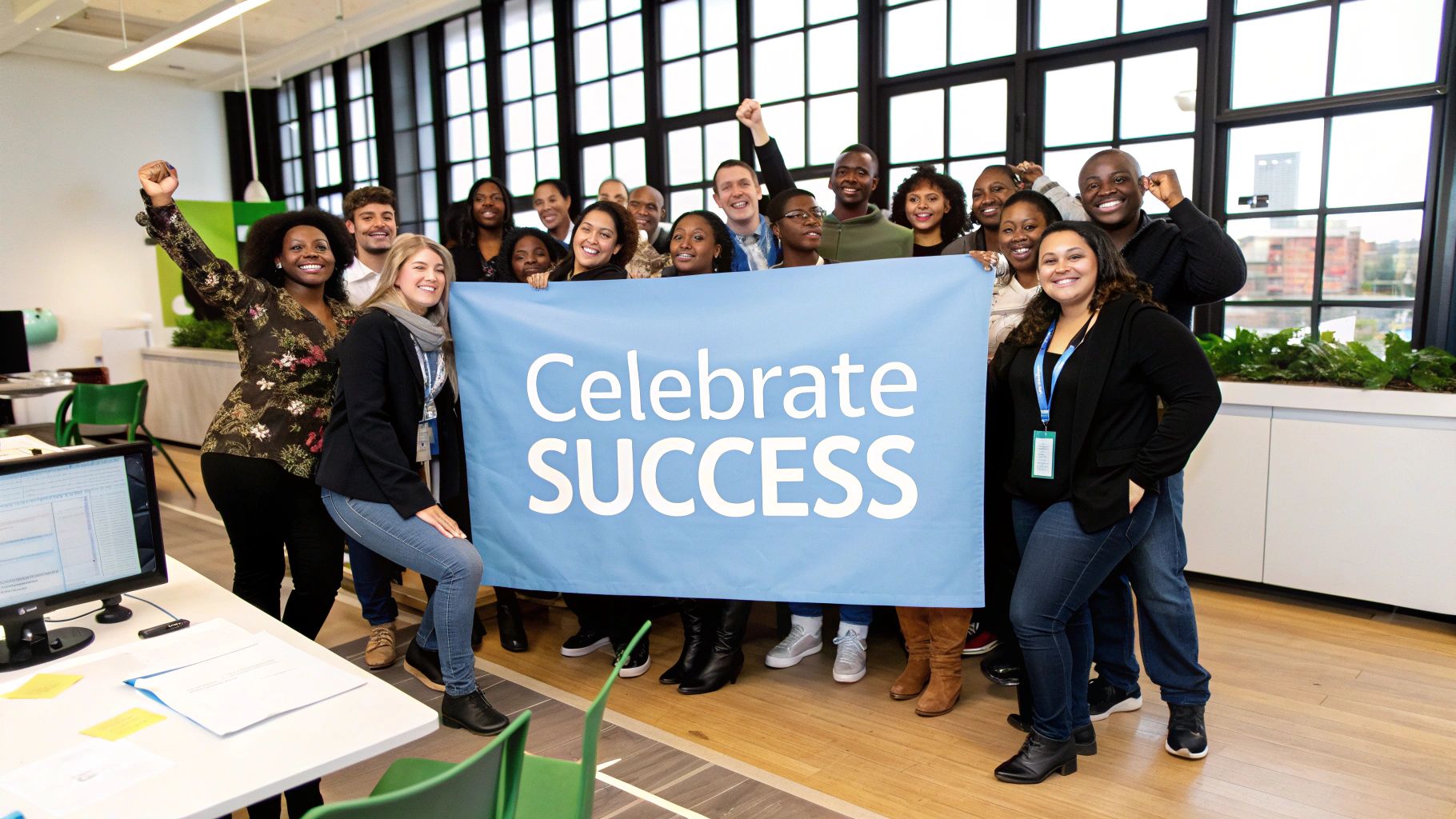Essential Tips for Improving Team Collaboration
Why Effective Team Collaboration Drives Business Success
Collaboration is the driving force behind thriving businesses. It's the combined power of individual skills and a shared vision that enables teams to achieve remarkable results, exceeding what any single member could accomplish alone. This is particularly evident in software development, where complex projects rely on seamless interaction between team members. Think of a software development team as a well-coordinated sports team; each player has a specific position and skill set, but it's their coordinated effort, led by the coach (team lead), that produces a winning outcome. This teamwork directly translates into enhanced efficiency and productivity.
The Measurable Impact of Collaboration on Business Outcomes
Boosting team collaboration has tangible, positive effects on a company's profitability. When teams collaborate effectively, they optimize workflows, eliminating unnecessary duplication of effort and minimizing wasted time. This heightened efficiency often leads to quicker project completion and increased profits. For instance, a development team using Pull Checklist to streamline code reviews can drastically reduce the time spent on this essential yet often lengthy process. This allows developers to concentrate on writing and delivering code, thus accelerating the development lifecycle.
Furthermore, collaboration nurtures a culture of innovation. By bringing together diverse viewpoints and promoting open dialogue, teams can devise more creative solutions and develop groundbreaking products or services. This can provide companies with a competitive advantage and fuel market share expansion. Picture a team brainstorming innovative features for a new mobile app. Through effective collaboration, they can synthesize their individual insights to create a truly user-friendly and innovative product.
However, ineffective teamwork can seriously hinder an organization’s success. A key global finding reveals that 86% of employees and executives cite poor teamwork as the leading cause of leadership failures, emphasizing the crucial role of effective collaboration within organizations. Moreover, fostering a collaborative atmosphere can significantly decrease employee turnover by as much as 50%, highlighting teamwork's direct impact on employee retention. For more in-depth statistics, explore further. This data emphasizes the importance of investing in tools and strategies that enhance collaboration.
Collaboration and Leadership
Effective leadership and collaboration are intrinsically linked. Leaders who champion and foster collaborative environments within their teams create a foundation for success. They act as mediators, facilitating open communication, valuing all perspectives, and resolving conflicts constructively. This cultivates a sense of psychological safety, empowering team members to contribute their ideas without fear of criticism, further boosting innovation and problem-solving. Much like a conductor guides an orchestra, a strong leader orchestrates the team's efforts, ensuring everyone works in harmony towards a common objective.

By prioritizing and consistently improving team collaboration, businesses can unlock their full potential, attain greater achievements, and cultivate a more engaging and rewarding work environment for their employees. This investment in collaboration is not just a recommended practice; it’s essential for success in today's competitive market.
Diagnosing Your Team's Collaboration Health

Before you can improve team collaboration, you need to understand its current state. This means performing a thorough diagnosis of your team's collaborative health. This isn't about abstract ideas, but a practical, hands-on assessment.
Conducting a Collaboration Audit
A collaboration audit offers a structured way to evaluate your team’s effectiveness. This audit should include measurable metrics and qualitative observations about the team’s culture. For example, you might track how often the team communicates, but also examine the quality of those interactions. Are team members truly listening to and respectfully engaging with each other? This comprehensive approach provides a more insightful picture.
To conduct a collaboration audit, follow these steps:
-
Targeted Team Surveys: Anonymous surveys can uncover valuable insights into team dynamics and how individuals perceive the team’s collaboration. Survey questions should explore communication effectiveness, how the team handles conflict, and the general satisfaction with collaborative efforts.
-
Communication Pattern Mapping: Observe how information flows within the team. Are there communication bottlenecks or information silos? Tools like Pull Checklist can visualize communication patterns, particularly within pull requests, revealing opportunities to improve code review collaboration. Visualizing the flow makes it much easier to identify and address communication gaps.
-
Workflow Analysis: Carefully examine existing workflows to identify obstacles that hinder collaboration. Are there unnecessary steps, unclear roles, or redundant tasks? Streamlined workflows can significantly boost team efficiency and collaboration.
Recognizing Warning Signs
Recognizing the signs of dysfunctional collaboration is essential for an effective diagnosis. These red flags indicate areas that demand immediate attention. For instance, information hoarding, when team members withhold critical information, can severely obstruct progress and damage trust. Another example is a toxic meeting culture, often marked by unproductive discussions and a lack of focus, which can drain team energy and impede collaboration.
To further assist in diagnosing collaboration issues, use the following framework:
To help you diagnose your team's collaborative health, consider using the following framework:
Collaboration Assessment Framework A structured approach to evaluate your team's current collaborative health across multiple dimensions
| Assessment Dimension | Key Indicators | Measurement Methods | Red Flags | |---|---|---|---| | Communication Effectiveness | Frequency of communication, clarity of messages, active listening | Team surveys, communication pattern mapping | Information silos, miscommunication, unresolved conflicts | | Meeting Productivity | Clear objectives, focused discussions, actionable outcomes | Meeting observation, post-meeting surveys | Unclear agendas, off-topic discussions, lack of follow-up | | Workflow Efficiency | Streamlined processes, clearly defined roles, minimal redundancy | Workflow analysis, time tracking | Bottlenecks, unnecessary steps, duplication of effort | | Team Dynamics | Trust, respect, psychological safety | Team surveys, interviews, observation | Information hoarding, toxic meeting culture, interpersonal conflict |
This framework helps to identify key areas to focus on during your assessment and provides a starting point for developing targeted improvements. Remember that each team is unique, so tailor the framework to your specific needs.
From Diagnosis to Action
The ultimate goal of this diagnostic process isn't simply to find weaknesses, but to create a roadmap for improvement. By understanding your team's strengths and challenges, you can develop specific strategies for enhanced collaboration. This honest assessment serves as the foundation for building a stronger, more collaborative team. It sets the stage for implementing effective teamwork strategies.
Building a Culture Where Collaboration Thrives

Improving team collaboration isn't simply about adding new tools or changing processes. It's about creating a supportive environment where teamwork can truly flourish. This requires a shift in organizational culture, prioritizing shared goals and open communication. Think of your team’s culture as the soil where collaboration grows. Fertile soil, rich with trust and respect, allows collaboration to blossom.
The Importance of Psychological Safety
A key ingredient for a collaborative culture is psychological safety. This is the shared belief that team members can speak freely without fear of negative repercussions. When individuals feel psychologically safe, they're more likely to share ideas, give constructive feedback, and take calculated risks.
This open exchange fuels innovation and effective problem-solving. Picture a team designing a new product feature. In a psychologically safe environment, even junior members feel comfortable challenging senior developers, potentially leading to a much better product.
Shared Goals Drive Collaborative Efforts
Along with psychological safety, shared goals are crucial for improving team collaboration. When everyone works towards the same objectives, it creates a natural sense of unity and shared purpose. This shared vision replaces internal competition with positive, collaborative energy.
This is especially vital in fast-paced environments like software development, where teams often juggle tight deadlines and complex technical issues. Office workers spend about 42% of their time collaborating, demonstrating the importance of teamwork in daily routines. However, low employee engagement, often linked to poor teamwork, costs the global economy an estimated $8.9 trillion annually – roughly 9% of global GDP. More detailed statistics can be found here: https://www.zoom.com/en/blog/workplace-collaboration-statistics/.
Navigating Cultural Differences in Diverse Teams
Today’s globalized workplace means teams are increasingly diverse, bringing together people from various cultural backgrounds. This diversity sparks innovation, but it also presents unique collaboration challenges. Different cultures have varying communication styles, decision-making processes, and views on hierarchy.
Successfully navigating these cultural differences requires sensitivity, open-mindedness, and adaptable communication strategies. This might involve cross-cultural training or establishing clear communication protocols that respect cultural nuances. You might be interested in: Team Collaboration Best Practices: Building High-Performing Teams.
Building a Collaborative Powerhouse
Transforming a siloed organization into a collaborative one takes a multifaceted approach. This involves recognition systems that reward teamwork, team-building activities that strengthen relationships, and structural changes that break down departmental barriers.
Implementing cross-functional project teams, for example, encourages collaboration across departments. This breaks down silos and fosters a collaborative organizational culture. These changes create a positive feedback loop, where greater collaboration leads to better results, further strengthening the collaborative culture.
Digital Tools That Actually Enhance Teamwork

A strong company culture is the bedrock of effective teamwork. But bringing that collaborative spirit to life requires the right digital tools. These tools are more than just software; they are the digital connections that facilitate communication and streamline workflows. Choosing wisely can significantly impact team functionality and collaboration.
Building a Purposeful Digital Ecosystem
The sheer volume of available collaboration tools can be overwhelming. The key is to build a digital ecosystem tailored to your team's unique needs. This means choosing tools that integrate well and address specific pain points, not just following the latest trends. This curated approach avoids digital busywork and ensures technology supports, rather than hinders, collaboration.
For example, if email overload is a problem, a dedicated communication platform like Slack or Microsoft Teams can help. Centralizing conversations reduces the need for email for quick exchanges. If project visibility is lacking, a project management system like Asana or Trello can provide a central hub for tracking and managing tasks.
Key Categories of Collaboration Tools
A wide array of tools exists to improve team collaboration, each with a specific purpose. Understanding these categories allows you to select the best fit for your team's workflow.
-
Communication Platforms: Tools like Slack, Microsoft Teams, and Google Chat streamline communication with dedicated channels for specific projects or topics. This keeps conversations organized and reduces email clutter.
-
Project Management Systems: Asana, Trello, and Monday.com help teams manage tasks, assign responsibilities, track progress, and visualize workflows. This promotes transparency and accountability. Pull Checklist further enhances project management within GitHub by embedding checklists directly into pull requests. This fosters better code review collaboration and consistency.
-
File Sharing and Document Collaboration: Google Drive, Dropbox, and Microsoft SharePoint facilitate seamless file sharing and co-authoring. This ensures everyone accesses the most recent versions, minimizing version control issues and confusion.
-
Video Conferencing Tools: Zoom, Google Meet, and Microsoft Teams offer face-to-face interaction, critical for building rapport and holding productive virtual meetings. These tools are essential for remote and hybrid teams.
Collaboration Tools Comparison
Analysis of different collaboration tool categories, their key features, and best use cases
To help illustrate the differences and potential benefits of each tool category, the following table provides a brief overview.
| Tool Category | Key Features | Best For | Limitations | Integration Capabilities | |---|---|---|---|---| | Communication Platforms | Real-time messaging, file sharing, integrations | Quick communication, project updates, reducing email overload | Can lead to notification fatigue if not managed effectively | Often integrates with other collaboration tools | | Project Management Systems | Task management, progress tracking, workflow visualization | Managing projects, assigning tasks, improving team visibility | Can be complex to set up and require ongoing maintenance | Can integrate with communication platforms, file sharing services, and other business tools | | File Sharing & Document Collaboration | Co-authoring, version control, centralized storage | Sharing files, collaborative document editing, ensuring data consistency | Requires user adoption and adherence to best practices | Integrates with other productivity and collaboration tools | | Video Conferencing Tools | Face-to-face interaction, screen sharing, recording capabilities | Virtual meetings, team building, remote collaboration | Requires reliable internet and can be challenging for large groups | Often integrates with calendar apps, communication platforms, and other collaboration software |
The table highlights some key considerations when choosing the right tools for your team. It's important to balance features with ease of use and integration capabilities to create a truly effective digital ecosystem.
The collaboration tools market is expanding rapidly. The global market is projected to grow from roughly $39.4 billion in 2023 to an estimated $116.3 billion by 2033. This growth reflects the increasing importance of collaboration for business success, particularly in hybrid and remote work environments. For a more in-depth look at these statistics, see this article.
Overcoming Challenges and Driving Adoption
Simply having the right tools isn't enough. Successful implementation requires addressing challenges and promoting consistent use. This involves training and support to overcome resistance and integrate tools into workflows.
Managing notification fatigue is also vital. Teams should establish clear communication protocols and notification settings to avoid being overwhelmed by alerts. By taking these proactive steps, you can transform digital tools from potential distractions into powerful resources that truly enhance team collaboration.
Building Collaboration Skills That Get Real Results
Effective teamwork relies not only on the right tools and a positive environment but also on strong collaboration skills. These skills empower team members to work together productively and aren't always inherent; they often need nurturing and development.
Essential Collaboration Skills for High-Performing Teams
Several core skills are crucial for effective teamwork. They underpin communication, problem-solving, and decision-making within a team.
-
Active Listening: This involves truly understanding what others are saying, not just waiting for your turn to speak. Active listening fosters trust and ensures everyone feels heard.
-
Constructive Feedback: Providing and receiving feedback well is vital for team growth. Constructive feedback focuses on specific actions and their impact, offering suggestions for improvement without personal criticism. For further reading on feedback, especially in a coding context, check out this resource: How to master code review best practices.
-
Navigating Conflict: Disagreements are unavoidable in any team. Successfully navigating conflict means addressing issues openly and respectfully, seeking solutions that benefit everyone.
-
Collaborative Problem-Solving: This involves working together to define problems, brainstorm solutions, and make decisions that leverage the team's combined knowledge. Tools like Pull Checklist can aid this process by providing a structured approach to address code review issues and improve decision-making within pull requests.
Developing Collaboration Skills: Practical Approaches
Building these vital skills requires a multifaceted approach, combining different learning methods and opportunities for practice.
-
Formal Training: Structured training programs can establish a foundation in core collaboration skills, offering strategies and methods for effective communication, feedback, and conflict resolution.
-
Peer Learning: Learning from colleagues through peer feedback, mentoring, and shared experiences can be a very effective way to develop collaboration skills.
-
Practice Opportunities: Providing opportunities for team members to practice these skills in a safe setting is essential for practical application. This could include role-playing, simulations, or team exercises.
Tailoring Skill Development
Different roles and work styles may benefit from targeted skill development. Team leaders, for instance, play a key role in establishing a collaborative atmosphere. Their development should focus on fostering psychological safety, facilitating communication, and resolving conflicts effectively.
This focused approach ensures skill development is relevant and productive, maximizing its impact on team performance.
Measuring the Impact of Skill Development
Tracking the effects of skill-building initiatives is important to demonstrate their value. This can be achieved through various methods:
-
Pre- and Post-Training Assessments: Evaluating skills before and after training helps measure the training's effectiveness and highlight areas for improvement.
-
Team Performance Metrics: Monitoring progress in key performance indicators, such as project completion rates, code quality, and team satisfaction, can show the real benefits of improved collaboration.
-
360-Degree Feedback: Gathering feedback from multiple perspectives – including peers, managers, and team members – offers a comprehensive view of an individual's collaboration skills and their influence on team dynamics.
By measuring the impact of skill-building, organizations can show a return on investment and align their efforts with business objectives. This data-driven approach supports continued investment in developing essential collaboration skills for high-performing teams.
Designing Workflows That Make Collaboration Effortless
Improving team collaboration goes beyond good intentions. It starts with carefully planned workflows that allow everyone to work together smoothly without unnecessary meetings or delays in decision-making.
Practical Frameworks For Different Collaborative Scenarios
Different tasks often call for distinct approaches, and the structure of a daily stand-up meeting differs from that of a strategic planning session. Well-constructed workflows meet these varied needs, ensuring each type of meeting or process is fit for purpose.
-
Daily Stand-Ups: Keep these gatherings short and to the point. Each team member should briefly mention what they completed yesterday, what they plan for today, and any roadblocks they are facing. This quick update helps everyone stay informed and spot potential issues early.
-
Strategic Planning Sessions: These sessions call for more detailed discussion. Incorporate visual tools, breakout groups, and guided exercises to invite diverse perspectives, ensuring that everyone gets a chance to contribute.
-
Project-Based Workflows: For ongoing projects, it is useful to integrate project management tools to monitor progress, assign tasks, and manage deadlines. This approach boosts visibility and accountability within the team. Additionally, integrating Pull Checklist into your workflow helps maintain consistent and thorough code reviews in GitHub.
Streamlining Decision-Making For Faster Results
Decision-making can be a major stumbling block in team projects if not handled efficiently. A clear decision-making process is essential for maintaining progress and reducing delays.
-
Clear Roles & Responsibilities: Clearly define who is in charge of decision-making, who collects input, and who implements the decisions. This clarity helps avoid confusion and ensures accountability.
-
Established Processes: Whether you use a simple majority vote, a consensus approach, or a designated decision-maker model, a consistent process makes choices more efficient and open.
-
Timely Resolution: Set firm deadlines for decisions to prevent overthinking. Often, a prompt and decent decision is preferable to waiting for the perfect one too long.
Knowledge Sharing: Capturing Insights Without the Burden
Sharing knowledge effectively is key to strong collaboration, but it should not become an extra chore. The aim is to gather important insights without creating additional work.
-
Centralized Knowledge Base: Establish a single location—whether it’s a shared drive, wiki, or project management tool—where important documents, meeting notes, and updates are stored. This hub makes it easier for everyone to access the information they need.
-
Regular Documentation: Encourage team members to document their work and share findings. Providing simple templates and clear guidelines can make this process more straightforward.
-
Knowledge-Sharing Sessions: Hold regular meetings to discuss insights, best practices, and lessons learned. These sessions foster a culture of ongoing learning and improvement.
Tailored Approaches For Diverse Team Compositions
Different teams may require different strategies for effective collaboration. Hybrid teams, with members spread across various locations, might rely more on digital tools. Cross-functional teams, made up of individuals from various departments, need clear communication channels and shared goals to bridge any gaps.
- Consider flexible meeting schedules and asynchronous communication methods.
- Establish clear escalation paths for addressing cross-functional issues.
- Adjust workflows accordingly to support smooth collaboration across varied team structures.
By addressing these unique team characteristics, you create workflows that truly support excellent collaboration.
Measuring What Matters in Team Collaboration
Improving team collaboration is a continuous journey. To ensure progress, you need to measure what truly matters, going beyond subjective opinions and gathering concrete data. This means creating a framework that tracks both quantitative metrics and qualitative indicators.
Quantitative Metrics: Tracking the Tangible
Quantitative metrics give you hard numbers to track progress. These are the "what" and "how much" of collaboration, painting a clear picture of team activity.
-
Productivity Measures: Track things like project completion rates, tasks completed per sprint, or lines of code produced. These offer solid proof of improved efficiency. Check out our article about how to master team productivity for more insights.
-
Tool Adoption Rates: Measure how actively your team uses collaboration tools like Pull Checklist. High usage suggests the tools are integrated into workflows and contributing to teamwork. Low adoption might indicate a need for better training or different tools. For instance, track how many pull requests use Pull Checklist to see its impact on code reviews.
-
Meeting Frequency and Duration: While not always a bad thing, too much meeting time can signal inefficient collaboration. Keep track of meeting frequency and duration to spot potential areas for improvement.
Qualitative Indicators: Capturing the Intangible
Numbers tell part of the story, but qualitative indicators offer valuable insights into the "why." These explore the human element of collaboration.
-
Team Satisfaction: Regularly assess team morale and satisfaction with collaborative processes using surveys or interviews. Happy teams tend to be more productive and collaborative.
-
Innovation Quality: Look at the quality of ideas and solutions that come from teamwork. Are innovative ideas being put into practice? Are they leading to measurable improvements?
-
Conflict Resolution Effectiveness: Pay attention to how the team handles disagreements. Does conflict lead to positive growth or unresolved tension? This reveals a lot about team dynamics.
Implementing Practical Feedback Loops
Data is only useful if it leads to action. Practical feedback loops turn measurements into real improvements.
-
Quick-Pulse Surveys: Short, frequent surveys offer real-time feedback on team morale and help identify potential problems early on. This keeps a finger on the pulse of the team.
-
Focused Retrospectives: After a project wraps up, hold dedicated retrospectives to discuss what worked well and what could be improved. This collaborative reflection promotes continuous improvement.
-
Observational Studies: Observing team interactions during meetings or work sessions can provide valuable context and insights beyond surveys or self-reported data.
Translating Data into Action
Successful teams use their data to make targeted improvements. This can involve small tweaks or bigger cultural changes.
-
Rapid Workflow Adjustments: If data reveals bottlenecks in your workflow, adjust your processes. This might mean streamlining decision-making or optimizing meeting schedules.
-
Targeted Skill Development: If surveys indicate a need for better communication skills, implement training programs focused on those specific skills.
-
Larger Cultural Shifts: If qualitative data points to a lack of psychological safety, leadership needs to model vulnerability and foster open communication.
By consistently measuring and analyzing data, teams can adapt their strategies, overcome challenges, and create a thriving collaborative environment. This data-driven approach is crucial for lasting improvement and organizational success.
Ready to boost your team's collaboration? Start your free trial of Pull Checklist today!
